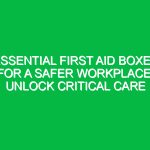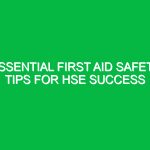Introduction
Hello everyone, and thank you for gathering today for this important Toolbox Talk. Our discussion will focus on a critical aspect of health, safety, and Environment (HSE) practices: **Know Your Limits at Work**. Understanding your physical and mental limits is essential in creating a safe workplace and ensuring your well-being on the job. By recognizing and respecting these limits, we can work more efficiently and safely while minimizing the risk of accidents and injuries.
Understanding Limits in the Workplace
Every job has its demands, whether they are physical, mental, or emotional. It’s crucial to understand that everyone has unique capabilities and limitations. This is the first step in **knowing your limits at work**.
- Physical Limits: These relate to your body’s ability to perform tasks. For instance, lifting heavy objects beyond your capacity can lead to injuries.
- Mental Limits: Working under stress or handling too many tasks at once can overwhelm you, causing burnout and reducing productivity.
- Emotional Limits: Emotional strain can affect your focus and decision-making, which is vital in maintaining a safe work environment.
The Importance of Knowing Your Limits
Recognizing your limits is not just about personal Safety; it’s about creating a culture of Safety within your team and organization. Here’s why knowing your limits matters:
- Prevents Accidents: Understanding your physical capabilities can help prevent injuries. For example, if you know you can’t safely lift a certain weight, you can ask for help or use mechanical aids.
- Increases Productivity: Working within your limits allows you to perform tasks more efficiently and effectively. When you’re not overexerting yourself, you can maintain a higher quality of work.
- Enhances Team Safety: When everyone knows their limits, it fosters a collaborative environment where team members can support each other, leading to a safer workplace.
Recognizing Your Limits
Knowing your limits requires self-awareness and regular self-assessment. Here are some strategies to help you identify and recognize your limits:
1. Self-Assessment
Take time to reflect on your performance. Ask yourself questions like:
- Am I feeling physically strained after completing my tasks?
- Do I find myself easily distracted or stressed?
- Are there certain tasks that consistently overwhelm me?
2. Seek Feedback
Don’t hesitate to ask your colleagues or supervisors for feedback. They may observe things about your performance that you might not notice. Open communication is key in understanding how your limits affect team dynamics.
3. Monitor Your Health
Regular health check-ups and paying attention to your physical and mental health can provide insights into your limits. If you’re feeling fatigued or unwell, it’s a sign that your body is reaching its limits.
Identifying Potential Hazards
Knowing your limits is closely linked to recognizing the Hazards that can arise in the workplace. Here are a few common hazards that can test your limits:
- Ergonomic Hazards: Poor posture or improper lifting techniques can lead to musculoskeletal injuries.
- Environmental Hazards: Working in extreme temperatures or with hazardous materials can strain your physical limits.
- Psycho-social Hazards: High-pressure environments and workplace bullying can affect your mental health and emotional limits.
Best Practices for Staying Within Your Limits
Implementing Best Practices can help you stay within your limits and promote a safer work environment. Here are some strategies to consider:
1. Take Regular Breaks
Breaks are essential for maintaining focus and productivity. Short breaks can help recharge your mental energy and reduce physical strain. Use this time to stretch, hydrate, or step away from your workspace.
2. Use Proper Equipment
Always utilize the right tools and equipment for the job. If you’re lifting heavy objects, ensure you’re using proper lifting techniques or mechanical aids. This can help prevent injuries and keep you within your physical limits.
3. Communicate with Your Team
If you feel overwhelmed or unable to complete a task, communicate this to your supervisor or team members. Teamwork is essential in ensuring everyone can work safely within their limits.
4. Prioritize Tasks
Understanding what tasks are urgent and which can wait is crucial. Prioritize your work so you can manage your time and energy effectively, reducing stress and potential burnout.
Real-Life Scenarios
Let’s consider a couple of scenarios to illustrate the importance of knowing your limits.
Scenario 1: The Heavy Lifting
Imagine John, who works in warehousing. One day, he encounters a box that is heavier than usual. Instead of asking a coworker for assistance, he attempts to lift it on his own. As a result, he strains his back, leading to significant pain and time off work. If John had recognized his physical limits and sought help, he could have avoided this injury.
Scenario 2: The Overwhelmed Employee
Sarah is a project manager who often takes on too many tasks at once. She feels stressed and finds it hard to concentrate, leading to mistakes in her work. After discussing her workload with her supervisor, they decide to redistribute tasks among the team. Sarah learns to manage her emotional limits and becomes more effective in her role.
Regulatory Compliance and Company Policies
Understanding and adhering to Regulations and company policies related to health and safety is paramount in knowing your limits at work. Regulatory bodies such as OSHA (Occupational Safety and Health Administration) provide guidelines to maintain a safe work environment. Familiarize yourself with these regulations and our company’s specific policies regarding Workplace Safety.
Compliance not only protects you but also the company from legal issues. Violating safety regulations can lead to fines and increased scrutiny from regulators. By knowing your limits and adhering to safety Standards, you contribute to a legally compliant and safe workplace.
Conclusion
In conclusion, knowing your limits at work is vital for your safety and the safety of your colleagues. By understanding your physical, mental, and emotional boundaries, you can work more effectively and prevent accidents. Remember to take breaks, use proper equipment, communicate openly, and prioritize your tasks.
Thank you for your attention and commitment to safety today. Let’s work together to ensure our workplace remains a safe environment for everyone. If you have any questions or would like to share your experiences related to knowing your limits at work, please feel free to speak up. Your insights are valuable in fostering a culture of safety.


